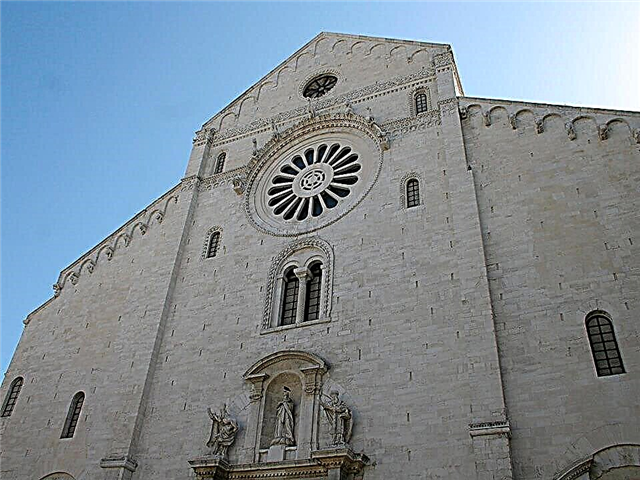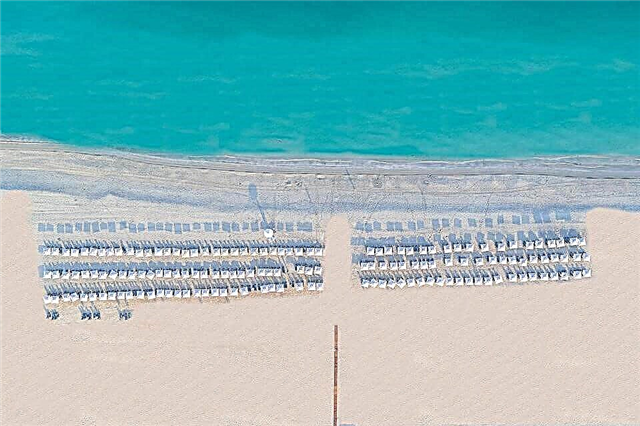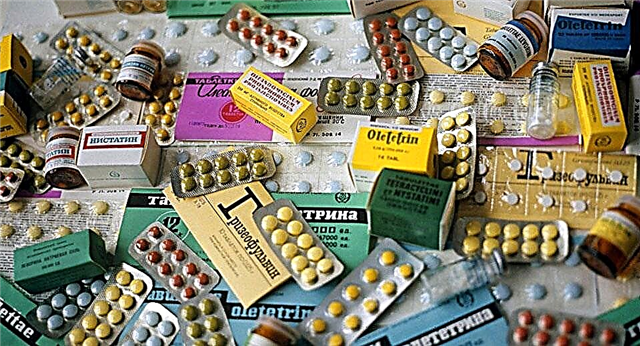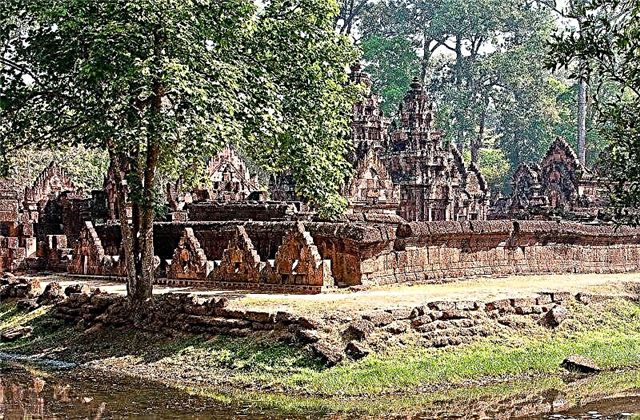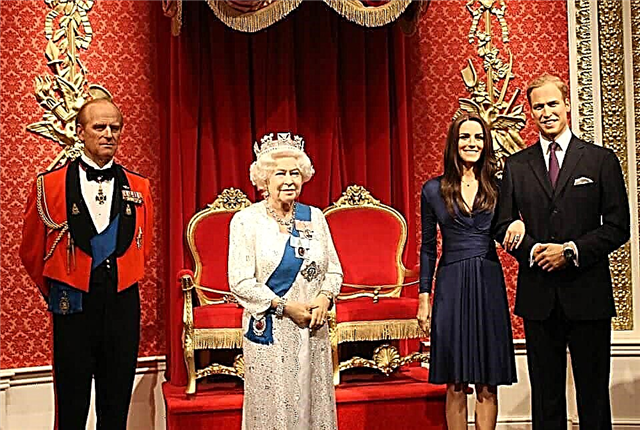London is associated with a prim, sophisticated aristocrat, arrogant and domineering. A brilliant city that is the capital of a strong, wealthy state, where the world's financial exchanges are concentrated, and it cannot be otherwise. The trail of a long dramatic, triumphant, sometimes tragic and bloody history is forever imprinted in monumental architectural structures, cultural and historical monuments. Among them there are very interesting places in London - the main symbols of England.
Big Ben

One of the main symbols is the famous Big Ben, whose name has several lexical meanings: the tower of Westminster Palace, a round clock installed on it and a large bell inside the clock mechanism. According to one version, this is the name of one of the lords sitting in the chamber, according to the other - a famous heavyweight boxer. The unique tower in the neo-Gothic style was erected during the reconstruction of the palace (1840).
A magnificent brick structure, faced with colored limestone, 96 m high, is based on a reliable concrete foundation 15 m deep. The dials of the famous chimes (there are 4 of them) are assembled from glassy opal (312 pieces), the edge of the discs is covered with gilding. Cast iron hands (2.7 meters long) and copper seconds hands (4.2 meters long) are visible from afar. The weight of the pendulum (300 kg) and the clockwork (5 tons) is impressive. Big Ben is London's most accurate clock, striking every hour. Tourists can view the tower only from the outside; it is forbidden to climb inside.
Tower of London

The oldest historical and architectural monument of Great Britain - the Tower Fortress is interesting not only for its authentic appearance, but also for the versatility of its purpose. Built in the 11th century. The fortress castle as a defensive structure soon began to be used as a prison for noble persons who were guilty before the king. There were executed 7 people who were related to the royal court, including the wives of Henry the 4th - A. Boleyn and C. Howard.
Ominous rumors and legends still circulate around the monumental structure. The purpose of the castle changed every century: in addition to a prison, it housed a mint, a zoo, a mint, an arsenal, a royal treasury, an observatory. Today, almost intact, the Tower is formally considered a royal residence where treasures are kept.
But along with this, the odious castle is a popular tourist attraction, where guided tours are conducted by law enforcement officers, dressed in strict Victorian uniforms on weekdays, and in artsy costumes of Tudor times on holidays. The robes of the guards are a kind of museum exhibit.
Visiting hours: November-February (Tue-Sat, 09.00-16.30; Sun-Mon, 10.00-16.30, entrance until 16.00).
March-October - the same, but until 17.30.
London eye

Such a name, by analogy with a huge all-seeing eye, was given to a widespread park attraction - a Ferris wheel. But the London wheel is striking in its height - 135 meters and surpassed many similar structures in the world. Such an extreme structure appeared thanks to the enthusiasm of the spouses-architects - J. Barfield and D. Marx, who took part in the competition dedicated to the meeting of the Millennium (2000) "Construction of the Millennium".
The jury of the competition rejected their project, but the architects infected with their idea found an investor. Installation of the attraction began in 1998. Huge parts of the structure were ferried along the Thames, experienced specialists worked on their connection. According to official documents, the Ferris wheel as an experimental facility was supposed to function for 5 years.
But the extraordinary popularity of the attraction among Londoners and tourists "extended the life" of the "London Eye", making it a real "hit" in the entertainment industry. From 32 glass capsule booths, which can accommodate 800 people at a time, you can see the entire magnificent panorama of the British capital. Unforgettable sensations are experienced by those who risk climbing to such a height.
The wheel works every day, 10.00 - 18.00.
Chinatown area

The Asian name, which is not quite familiar to the European ear, did not appear in London from scratch - there is a Chinese microdistrict Chinatown practically in the center of the city. It was formed as a tiny part of the not very prosperous Soho district, in which all sorts of outcasts, such as the French Huguenots, Hong Kong Chinese and interned Italians, originally settled.
Gradually, the settlement of foreigners turned into a kind of exotic attraction with its own way of life, traditions and flavor. The Chinese do not live here permanently, they trade, work in various establishments. Today, in a small area where old English buildings have acquired an Asian look, where Chinese restaurants, shops and shops with exotic goods stretch out in a continuous line, you can see a lot of interesting things.
An exciting shopping awaits you here: unique Tibetan herbs, unusual spices, vegetables, spices, exotic alcohol and other rarities are sold in local shops. One of the restaurants serves traditional Chinese cuisine at fairly reasonable prices.
Zoo

London Zoological Park, opened in 1928, is not just an entertainment and entertainment facility, but a major scientific center designed to study the animal world. The London zoo organizers pioneered the opening of the world's first serpentarium, aquarium, insectarium and zoological corner for children. It is noteworthy that the huge zoo is maintained at the expense of the charity of individuals and organizations - the need for this institution is so great.
To see all the sections and pavilions here, to enjoy the landscape beauty of the park, you need to devote at least 3 hours to this. In 3 halls of the aquarium, numerous species of the inhabitants of the seas and oceans are presented. In the serpentarium, you can see the most exotic reptiles, from tiny snakes to huge reptiles.
An amazing sight awaits everyone in the "Gorilla House", built in the Art Nouveau style. And the collection of incredible colors of tropical butterflies in pavilion B. U. G. S. makes an amazing impression, as does the section "African Bird Safari".
Open to the public: September-mid-February - from 10 am to 6 pm.
- 02-23. 02 - from 10.00 to 17.00
- 02-28. 03 – 10.00-17.30
- 03-07. 09 – 10.00-18.00
Coca-Cola London Eye ticket - £ 27
Ticket to the Tower of London and the Royal Treasures Exhibition - £ 27.50
Tower Bridge ticket - £ 9.80
Westminster Abbey entrance ticket and audio guide - £ 21
Madame Tussauds ticket - £ 29
St Paul's Cathedral Fast Track Ticket - £ 17
Skyscraper "Shard" - entrance ticket and champagne - £ 27.20
Thames Barrier

Such a rather strange name bears a wonderful coastal park, which is an excellent example of how you can ennoble the place of production that pollutes the surroundings. This is the territory of the royal docks, which was used for many years as a landfill for the transportation of imported and exported raw materials, for 130 years it has become environmentally dirty, so the London authorities turn the industrial zone into a "resting place" for citizens, "green lungs" of the capital.
The Thames Barrier is also a grand dam that blocks the river across and protects the city from flooding. Opened in 2000, a piece of landscape art has become a favorite vacation spot for Londoners. Green lawns and ornamental lawns, flower beds, gravel areas with benches spread over 22 acres of land, adorn the once unsightly territory.
At the entrance to the "Thames Barrier" 32 fountains sparkle with crystal streams. A pavilion of memory dedicated to the local residents who died during the Second World War was opened here.Shaped hedges of yew, honeysuckle and other shrubs line the walking paths. There are children's and basketball courts, picturesque bridges, picnic areas in the popular park.
Open for visits from 07:00 until dark.
The entrance is free.
Spencer House
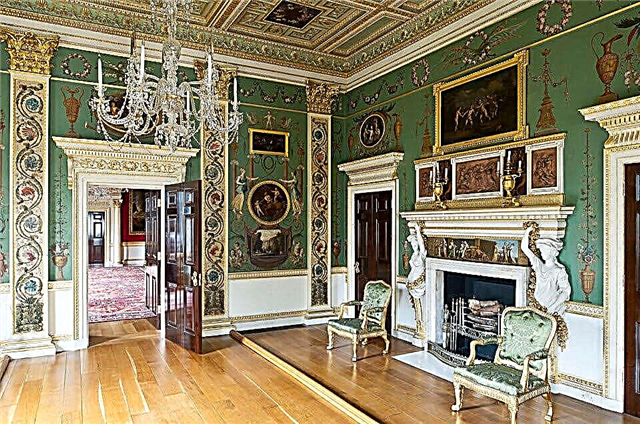
A unique luxurious neoclassical palace built in the 18th century. under the earl of the first generation of the Spencers, became especially popular with tourists after the death of Princess Diana. During her lifetime, she also had a relationship with the old mansion, renting it out, as her ancestors had done since 1895. It was Spencer House that laid the foundation for neoclassical architecture in London with its graceful appearance.
The highest London nobility held various celebrations in the palace, which were attended by the most famous English aristocrats. After the damage caused during the war, the mansion was carefully restored, many valuables were returned, and it again began to be rented out to various clubs, offices and received tourists.
They can stroll around the palace, admire its charming exterior, velvet lawns and ornamental shrubs in front of it. Inside, admire the marble sculptures, golden palm trees, entwining the columns, magnificent interiors of 11 rooms of the palace.
Excursions (groups up to 20 people) are held every Sunday, except January and August, from 10.30 to 17.45
Marshalsea Prison

Everyone who has read Dickens' novel about the sad fate of Little Dorrett is already familiar with the notorious Marshallsea prison, in which Dickens's heroine was born and grew up. After all, Dickens himself knew this awful place very well - his father was sitting here for debts to a baker. To free his father, to pay off his debt, Dickens, a teenager, got a job at a wax factory 8 km from his home. After working for 10 hours, I came back, and so every day.
Now from the gloomy apartment buildings of the prison (the prisoners lived in families) there is only one 4-meter wall, located next to the street. Borough High Street. It has 2 arched barred openings that served as prison gates. The wall, covered in places with moss and ivy of "oblivion", recalls the harsh customs of the past.
You can sit on a bench in a landscaped courtyard, indulge in contemplation of the wall, then go to the nearby Anglican church. She is also present in Dickens' novel and plays an important role in the fate of little Dorrit. It is no coincidence that there is an image of a girl on the stained glass window of one of the church windows.
Theater "Coliseum"

The first production in the form of a variety show took place in the largest London theater "Coliseum" on December 24, 1904, and since that time premieres of famous performances have been regularly held on its stage. The theater building, designed by the venerable architect F. Matchen, looks great and is deservedly considered a masterpiece of architecture. Its facade is decorated with graceful columns and expressive sculptures; the top of the dome is crowned with a model of the globe with the name of the theater.
The interior interiors captivate the viewer with lush beauty. A luxurious velvet curtain, gilded cupids on the walls, luxurious boxes are impressive. The huge hall can accommodate 2,358 people. Here you can hear arias of the most famous classical operas staged by venerable directors and performed by the best opera singers.
The London public has the opportunity to listen to opera performances from almost all theaters in the world. Frequent viewers are members of the royal family, famous politicians and cultural figures. Despite the considerable age of the establishment, everything inside is technologically equipped at a modern level. There are 2 restaurants open, and if desired, spectators can bring champagne and snacks to the box.
Westminster Abbey

A true British shrine, the oldest church of St. Peter or Westminster Abbey is located in the historic site of London - Westminster. Since 1987 it has been a UNESCO World Heritage Site. Within the walls of the monastery complex, the 1000-year history of Christianity and England is captured. The first temple, presumably, was erected in this place in the 7th century, when, according to legend, a local fisherman saw Saint Peter in a dream.
Under King Edward the Confessor in the 11th century. the temple was rebuilt into a majestic monumental structure, and here he was also buried. It was here, where the coronation throne was preserved, that the coronation of English monarchs took place, and royal weddings took place (16). The most famous of these are the wedding ceremonies of Prince Albert and Elizabeth I (1923) and the current Queen Elizabeth.
The wedding of Prince William and Kate Middleton (2011), which was broadcast around the world, aroused great public interest. The ashes of the great personalities of Britain from among the ruling and church people, scientists, poets and writers are buried within the walls of the abbey. Visiting the unique sanctuary leaves a deep impression.
Opening hours: Mon, Tue, Thu, Fri - 06.30-15.30.
Wednesday - 16.30-18.00; Sat - 09.30-13.30.
Madame Tussauds museum

The extravagant museum, opened in 1835, is located in the north of Westminster, the richest district in London. At the entrance, everyone is greeted by a small figure of an elderly lady in a black dress, with a white cap on her head - Madame Tussauds herself. Here, not only the number of wax copies (more than 400) is striking, but also their extraordinary similarity with prototypes. All celebrities look truly alive, and not like frozen mummies.
Talented followers of Tussauds have captured idols in relaxed poses. It is difficult to convey in words the strong impression of visiting an unusual museum. Technological innovations have greatly expanded the possibilities for creating wax sculptures. For example, the use of modern types of plastic, artificial leather allows you to make the most believable nails and eyes.
Now it is possible to make figures move and even speak, reacting to certain behavior of visitors. The new attraction-journey into the Middle Ages "The Spirit of London" is especially striking, when tourists in miniature "taxis" ride through the halls that recreate bygone eras. Familiar characters make welcoming gestures, the military salutes.
Opening hours on a "floating schedule", it is recommended to learn about the opening on the day of the tour on the museum website.
Saatchi Gallery

Shocking, shocking, unusual, intriguing - such epithets can be used to describe the Museum of Contemporary Conceptual Art - the Saatchi Gallery. It was created by the collector and talented art dealer Charles Saatchi, who is passionate about art nouveau in painting, collecting paintings, installations, prints and graphics by contemporary artists. His extraordinary collection, once exhibited for all to see, became the basis of a large museum, which is now housed in the premises of the former barracks, occupying 4 floors.
The exhibits of museum exhibitions are a constant subject of controversy, criticism, discussion and great public interest. For the majority of ordinary people, many of the presented "masterpieces" are not very clear, but capture the imagination with their abstractness and understatement. An unusual installation with a luxurious car bent in half, strung on a metal pipe amazes and makes you think.
Busts of thinkers of the past with eyes, hearts, faces pierced with tridents cause shudder and awaken thought. Abstract paintings, photos do not let go of their mystery for a long time. The gallery is the venue for various art workshops.
Opening hours: daily, from 10.00 to 18.00.
Entrance b / n, except for individual expositions.
Eltem Palace

When at the beginning of the 20th century. the luxurious royal palace of Henry the 8th turned practically into ruins, the married couple Courtauld decided to completely restore the "architectural treasure". Two young progressive architects got down to business, combining all the authentic fragments of the palace. On this basis, two magnificent buildings were erected, decorated with Gothic elements of the Tudor era, neoclassical details of Italian and French Art Deco architecture.
Both buildings were united into one complex by an elegant rotunda with a glass dome. Visitors really like the truly royal decoration of the palace, designed by the famous designers of the 30s of the 20th century - the Swede Engstrom and the Italian Malacrid. One cannot but admire the lacquered panels made of expensive wood, the picturesque wall panel in the hall of the palace.
The main entrance is guarded by 2 people depicting ancient guards - a Roman and a Varangian. Ancient Greek motifs in the design of the dining room and Renaissance bathroom finishes are impressive. Today, an architectural wonder, included in the national heritage of England, is given over to an elite hotel.
Working hours: Mon, Tue, Wed, Sun - from 10.00-17.00 (01.04-04.11).
10.00-16.00 (05.11-17.02, 23.02-28.03 on Sun).
10.00-16.00 (18.02-22.02, Mon-Wednesday).
Kensington palace

A solid, strict architecture building surrounded on 3 sides by a park - Kensington Palace, in fact, is the cradle of English kings from the 17th century. The first owners and creators were William of Orange and Mary II. Their portraits occupy a worthy place in the palace gallery. The famous Queen Victoria was born in it, from here she ruled the state and lived in a happy marriage with Prince Albert. Victoria's monument by her daughter Louise is installed on the alley leading to the palace.
The famous princess Diana lived in the old chambers for 16 years with her children and her husband. The latter fact especially attracts tourists here. Now the family of Prince William lives in one half of the palace, excursions are held in the second (entrance from the park). On the right side of the alley leading to the palace, Diana's garden is laid out, fenced around the perimeter by covered floristic galleries, unusually cozy.
Its center is decorated with a picturesquely decorated pool with fountains, around which densely growing white flowers - the White Garden, created by the palace gardeners for the 20th anniversary of Diana's death. Inside, in several rooms, a large-scale exhibition of Diana's wardrobe is organized.
Open for visits: 10.00-17.00 (Mon-Fri).
Borough Market

As you know, the British, being disciplined in everything, have a very responsible attitude to nutrition, attaching great importance to the quality of products. Therefore, in London, the oldest food market Borough (Borough Market), which existed since the 12th century, is so in demand. Successfully developing enterprise in the 15th century. received a letter of trust from King Edward the 6th and subdued all nearby markets. It is in Borough, on the street. Dorouqh Hiqh Street Londoners were in a hurry for fresh meat, cheese, vegetables, milk, creating huge traffic jams.
Therefore, the market was moved to Southwark Street, where it is still located. Shoppers move along the colorful stalls in a continuous stream, especially on weekends - Saturday (the market is closed on Sunday). Perfect cleanliness reigns everywhere, all windows are tastefully decorated. Fruit and vegetable breakdowns are a picturesque still life pleasing to the eye.
The choice of quality meat products is unusually wide: you can buy sausages of the most exotic types: venison, wild boar, zebra, etc. The choice of seafood, cheeses, dairy products controlled by expert commissions is impressive. Borough Market has been featured in several feature films.
Working days: every day, except Sunday.
London dungeon

Not far from Westminster Bridge, opposite Big Ben, there is a unique museum or, as it is also called, a "theater of horror" with acting actors. The vast underground space under County Hall was turned into a medieval torture museum in 1975, which has become extremely popular with Londoners and tourists. Especially fans of horror films and thrillers like it here, and in general, fans to tickle their nerves.
The rather gloomy atmosphere of the interiors, the possibilities of modern lighting allowed to create here the oppressive atmosphere of the real Middle Ages. Against this background, a performance under the motto “Fear is a funny thing” is “played out” with the participation of actors and visitors involved in the performance. First, everyone finds themselves in the "Labyrinth of Lost Souls" (a room with mirrored walls), when visitors wander among their reflections, frightened by unexpectedly appearing here and there, unexpectedly emerging characters of the Middle Ages.
Here you can meet Henry the 8th, Jack the Ripper, Todd the barber who kills his clients, etc. You will be "sentenced" to be hanged (attraction "Descent to the Underworld"), declared state criminals.
Working hours: Mon-Fri - 10.00-17.00 (Thu - from 11.00); Sat, Sun - 10.00-18.00.
Sherlock Holmes Museum

The famous London detective is considered by many to be a real person, and not the fruit of the literary fiction of Conan Doyle - the image of Sherlock Holmes is so believable. Therefore, in 1990, it was on the street. Baker Street (the hero lived on it) in a 4-story mansion N 239, a museum of a popular literary character was opened. The creators of the museum tried to recreate the setting here, exactly repeating the description of K.-Doyle.
The entrance is guarded by a real policeman in 19th century outfit, the guides are dressed like Victorian maids. On the 1st floor there are ticket offices and a shop selling souvenirs of the corresponding theme. On the 2nd floor, the furnishings of Holmes's study and bedroom are reproduced with objects familiar to readers: laboratory flasks and test tubes, a detective's violin, Watson's revolver, letters and the famous pipe on the mantelpiece, etc.
Here you can sit in Sherlock's chair in front of a burning fireplace. 3rd floor - Mrs. Hudson's property. An exhibition of K.-Doyle's literary heroes made of wax, including the head of the notorious Baskervilles dog, can be seen on the 4th floor.
Open for visits - every day 09.30-18.00, except Christmas.
Golden doe

Such a beautiful name is given to a small ship - the galleon of the famous pirate and admiral, who played an important role in the development of England, Francis Drake. On the ship "Pelican" he made an expedition around the globe (1577-80), and before entering the Strait of Magellan he gave the ship the name "Golden Hind" (coat of arms of the sponsor of Halton's voyage). Today, a modern replica of the galleon (1973) sits on the pier in Southwark, serving as a kind of museum since 1996.
Until that time, the galleon, like its legendary predecessor, conquered many ocean expanses (225 thousand km), passed Drake's route around the world. The ship "Golden Hind" was filmed in 3 feature films, it is used as an educational object in organizing school trips. Teens are delighted to "become sailors" in interactive lessons on the history of English sailing.
Wellington arch

A magnificent structure located near Green Park, the triumphal Arch of Wellington or the Constitution, was erected at the behest of George VI to commemorate the British victories in the war with Napoleon. In its original form, the Arch was crowned with an 8.5-meter statue of the 1st Duke of Wellington, which was removed when the structure was moved to its current location. Now its top is decorated with a bronze quadriga, ruled by an "angel of peace".
Until 1992, a tiny police station was located inside the arched cavity, and since 1999 the premises of the arch have become a museum and an object of cultural and historical heritage. The exposition of 3 floors of the 1st half introduces a detailed "biography" of the architectural monument. The second part began to serve as a ventilation shaft of the London Underground after its opening. Wellington Arch looks very impressive against the backdrop of the surrounding greenery.
Greenwich observatory

The English village of Greenwich (now London borough) is famous for the fact that the prime meridian passes through it, from which the time of the geographic zones of the planet is counted. The Greenwich meridian is the starting point of geographic longitudes, adopted in 1884. The flow of tourists rises here to visit the Greenwich Observatory, founded in 1675 under Charles II. It is located on the banks of the Thames, on the hill of Greenwich Park, from where you can see all of London.
Today the old buildings of the observatory have been turned into the Museum of Astronomical and Navigational Devices and Instruments.The exhibits of the museum clearly reflect the history of the development of methods and means of measuring time, determining the location of objects using coordinates. The expositions "tell" about the ships that disappeared in the seas and oceans, when there was no time calculation and coordinate system. Modern achievements in this area are also reflected.
Opening hours: daily, 10.00-17.00, admission is allowed until 16.30.

